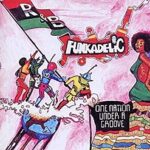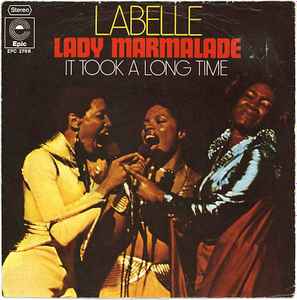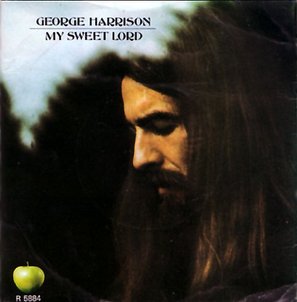 Funkadelic’s “One Nation Under a Groove” is more than a song—it is a manifesto, a declaration of musical and social liberation, and a masterclass in the power of groove. Released in 1978 as the title track of their landmark album, the song encapsulates the essence of George Clinton’s Parliament-Funkadelic collective: boundary-defying creativity, electrifying energy, and an unapologetic embrace of rhythm, soul, and communal joy. With its infectious bassline, hypnotic guitar riffs, and anthemic chorus, “One Nation Under a Groove” is a timeless anthem that transcends its era, uniting listeners under the universal language of funk.
Funkadelic’s “One Nation Under a Groove” is more than a song—it is a manifesto, a declaration of musical and social liberation, and a masterclass in the power of groove. Released in 1978 as the title track of their landmark album, the song encapsulates the essence of George Clinton’s Parliament-Funkadelic collective: boundary-defying creativity, electrifying energy, and an unapologetic embrace of rhythm, soul, and communal joy. With its infectious bassline, hypnotic guitar riffs, and anthemic chorus, “One Nation Under a Groove” is a timeless anthem that transcends its era, uniting listeners under the universal language of funk.
The track represents a culmination of Funkadelic’s evolution throughout the 1970s. Blending psychedelic rock, R&B, and funk into a kaleidoscopic sound, the band had already established itself as a radical force in music. By the late 1970s, George Clinton and his collaborators were pushing further, not only in musical experimentation but also in using their art to foster unity, joy, and liberation. “One Nation Under a Groove” perfectly embodies this ethos, combining technical brilliance with a message that remains profoundly resonant decades later.
The Cultural and Musical Landscape of 1978
By 1978, the music world was in a state of flux. Disco dominated dance floors, rock continued to evolve, and funk had become a vehicle for both musical innovation and cultural expression. Funkadelic, along with Parliament, was at the forefront of this movement, creating music that defied categorization.
Funk was more than just rhythm and groove—it was a social statement. Emerging from African American musical traditions, funk expressed liberation, resilience, and joy. Bands like Funkadelic and Parliament used their music to challenge conventions, celebrate individuality, and forge a sense of collective identity. “One Nation Under a Groove” reflects this broader cultural moment: it is both a danceable track and a call for unity, inviting listeners to participate in a shared musical and social experience.
Composition and Musical Innovation
Musically, “One Nation Under a Groove” is a triumph of arrangement and texture. The song opens with a hypnotic, syncopated bassline that immediately establishes its groove. Bootsy Collins, Funkadelic’s virtuoso bassist, delivers a performance that is both precise and infectious, creating a foundation that anchors the song while inviting the listener to move.
Layered over this foundation are electrifying guitar riffs, swirling keyboards, and polyrhythmic percussion. Funkadelic’s musicianship is on full display, with each instrument contributing to a dense, textured sound that remains remarkably coherent. The production balances complexity and clarity, ensuring that every note, fill, and vocal flourish serves the overall groove.
George Clinton’s influence as bandleader and visionary is evident throughout. He understood that funk was as much about communal energy as it was about individual virtuosity. The arrangement of “One Nation Under a Groove” allows space for each musician to shine while maintaining a unified, unstoppable momentum.
Lyrics and Social Resonance
Lyrically, the song is an anthem of empowerment and inclusivity. Clinton’s words are direct, celebratory, and infectious:
“So wide, you can’t get around it, so low, you can’t get under it, so high, you can’t get over it”
These opening lines establish the immensity and inevitability of the groove—a metaphor for music’s ability to transcend barriers, connect people, and inspire freedom. The chorus, with its repeated refrain “One Nation Under a Groove”, emphasizes unity and collective joy. It is at once a literal celebration of the groove and a metaphor for a society in which music brings people together beyond divisions of race, class, or background.
The lyrics encourage participation, not passive listening. Clinton invites his audience to dance, to join the communal experience, and to recognize the transformative power of music. In doing so, the song becomes both a party anthem and a sociopolitical statement, asserting that joy, freedom, and unity are not merely personal experiences—they are collective imperatives.
Production and Sonic Craftsmanship
The production of “One Nation Under a Groove” reflects Funkadelic’s mastery of the studio as an instrument. Unlike many tracks of the era, the song blends live performance energy with meticulous studio techniques. Each instrument occupies a distinct sonic space, and the layering of guitars, keyboards, percussion, and vocals creates a sense of depth and dimension.
Horn stabs and rhythmic accents punctuate the groove, adding dynamic contrast and driving the song forward. The vocal arrangement is equally sophisticated: Clinton’s lead vocals are supported by call-and-response backing vocals, creating a rich tapestry of sound that mirrors the communal ethos of the lyrics. Even decades later, the mix remains vibrant, capturing the immediacy of a live performance while highlighting the intricacies of the studio craft.
Chart Performance and Reception
Upon its release, “One Nation Under a Groove” became Funkadelic’s biggest commercial success, topping the Billboard R&B chart and reaching the top ten on the Billboard Hot 100. The song’s accessibility, infectious rhythm, and unifying message helped it cross over from niche funk audiences to mainstream listeners.
Critics praised the track for its musical innovation and cultural significance. Many highlighted Funkadelic’s ability to fuse complex musicianship with a joyous, danceable energy, and the song became emblematic of the band’s unique approach. It solidified Funkadelic’s reputation as one of the most forward-thinking and influential bands of the 1970s.
Influence on Funk, R&B, and Popular Music
“One Nation Under a Groove” has had an enduring impact on music across genres. Its infectious rhythm and emphasis on groove influenced subsequent generations of funk, R&B, hip-hop, and dance artists. The song’s bassline and guitar patterns have been sampled and referenced in countless tracks, demonstrating its foundational role in modern rhythm-driven music.
Artists from Prince to OutKast have drawn inspiration from Funkadelic’s ability to blend musical complexity with mass appeal. The track’s combination of virtuosity and accessibility set a benchmark for artists seeking to create music that is both intellectually and physically engaging.
Beyond its musical influence, the song’s message of unity and liberation resonates culturally. Its title and lyrics have been invoked in discussions of social cohesion, musical celebration, and the power of collective joy. In this sense, the track transcends its genre, functioning as both a cultural touchstone and a musical template.
Musical Analysis
From a technical perspective, “One Nation Under a Groove” is notable for its use of syncopation, polyrhythms, and harmonic layering. The bassline, anchored in funk’s signature downbeat emphasis, interlocks with percussion in ways that create a sense of propulsion and tension. Guitar riffs oscillate between rhythmic chording and melodic flourishes, adding texture and movement.
The keyboards, provided by Bernie Worrell and other members of the collective, introduce psychedelic elements, with swirling textures and unexpected chord shifts that keep the listener engaged. Horns punctuate key moments, adding brightness and accentuating the song’s jubilant energy. Vocally, Clinton’s dynamic delivery—combined with backing harmonies and call-and-response structures—creates a sense of conversation and interaction, reflecting the communal ethos of the song.
The overall arrangement exemplifies Funkadelic’s genius in balancing complexity and accessibility. Each element contributes to the groove, ensuring that the song functions as both an intricate musical composition and a physical, danceable experience.
Cultural Legacy
“One Nation Under a Groove” remains one of Funkadelic’s most celebrated and influential works. Its fusion of musical innovation, lyrical empowerment, and unifying energy ensures its enduring relevance. The track is frequently cited as one of the greatest funk songs of all time, appearing on numerous “best of” lists and in retrospectives of 1970s music.
The song’s impact extends beyond music. It has become a symbol of liberation, community, and joy, frequently referenced in cultural discussions about music’s power to unite people. Its message resonates as strongly today as it did in 1978, reminding listeners that music is both a personal and collective experience—a force capable of transcending boundaries and bringing people together.
Sociopolitical Dimensions
Although the song’s primary focus is musical and celebratory, it carries sociopolitical undertones. Funk, as a genre, has long served as a vehicle for commentary on social issues, and “One Nation Under a Groove” is no exception. By promoting unity and collective joy, the song implicitly critiques social divisions and emphasizes inclusivity. The notion of a “nation under a groove” suggests a world in which music, creativity, and communal experience triumph over conflict and alienation.
The track also exemplifies the role of African American musical innovation in shaping popular culture. Funkadelic’s synthesis of rock, funk, and psychedelic elements reflects a broader history of Black musical creativity influencing mainstream culture while maintaining its roots in African American experience. “One Nation Under a Groove” thus functions as both a celebration of musical artistry and a statement of cultural pride.
Influence on Dance and Club Culture
The song’s infectious rhythm and call to movement made it a staple in dance clubs and party settings. DJs and audiences embraced its groove-driven energy, and the track helped solidify Funkadelic’s reputation as a band capable of transcending the traditional boundaries of live performance and studio recording. Its appeal to both musicians and dancers highlights the track’s dual function as a musical composition and a communal experience.
Moreover, the song’s structure—combining repetitive grooves with dynamic variations—provided a blueprint for later dance and electronic music producers. Its emphasis on rhythm, layering, and audience engagement anticipates many principles central to contemporary dance music, from house to funk-infused hip-hop.
Conclusion: A Timeless Anthem of Funk
“One Nation Under a Groove” exemplifies Funkadelic at their most visionary. Its combination of infectious rhythm, intricate musicianship, and socially resonant lyrics creates a song that is both timeless and immediate. George Clinton and his collaborators crafted a track that celebrates individuality while promoting unity, dance while conveying a deeper cultural message.
The song remains a cornerstone of funk, influencing countless artists and defining an era in music history. Its grooves, melodies, and communal energy continue to inspire listeners, reminding us that music is a unifying force capable of transcending time, space, and social barriers.
By blending technical brilliance with emotional resonance, “One Nation Under a Groove” captures the essence of Funkadelic’s artistry. It is a declaration of musical freedom, a celebration of collective joy, and an enduring reminder that the power of a groove can unite people across generations. More than four decades after its release, the song continues to pulse with vitality, proving that funk is not just a genre—it is a way of life.
Funkadelic’s anthem demonstrates that music has the power to create nations, not of borders, but of rhythm, spirit, and shared experience. “One Nation Under a Groove” is, quite literally, a nation unto itself—a sonic revolution that continues to resonate with anyone willing to surrender to the beat.


